Professional Development in Health and Social Care
VerifiedAdded on 2022/12/29
|15
|3801
|69
AI Summary
This document discusses the concept of professional development in health and social care, including the importance of continuous learning and improvement. It covers topics such as skills evaluation, learning styles, goal setting, and overcoming barriers to professional development. The document also explores various sources available for professional development.
Contribute Materials
Your contribution can guide someone’s learning journey. Share your
documents today.
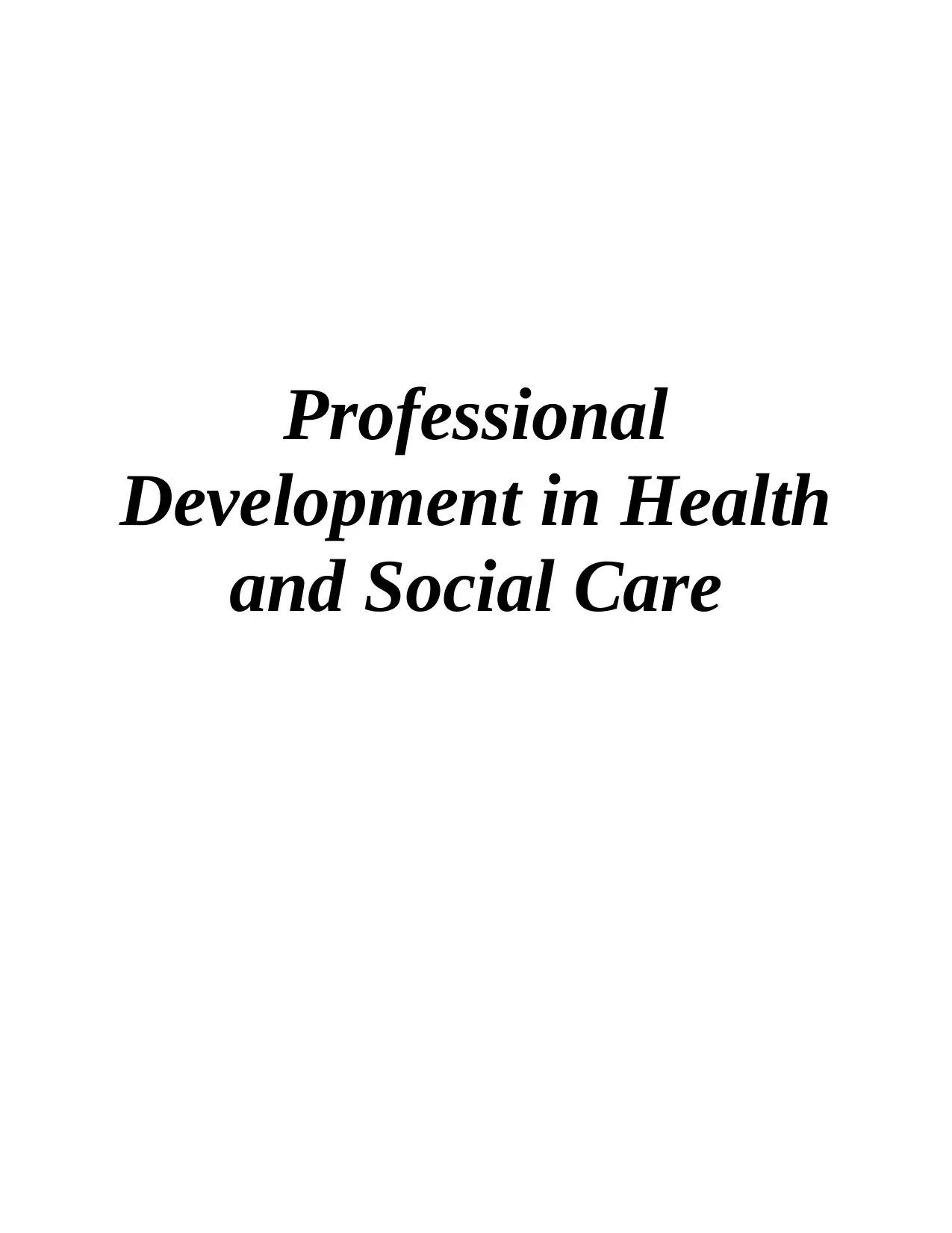
Professional
Development in Health
and Social Care
Development in Health
and Social Care
Secure Best Marks with AI Grader
Need help grading? Try our AI Grader for instant feedback on your assignments.
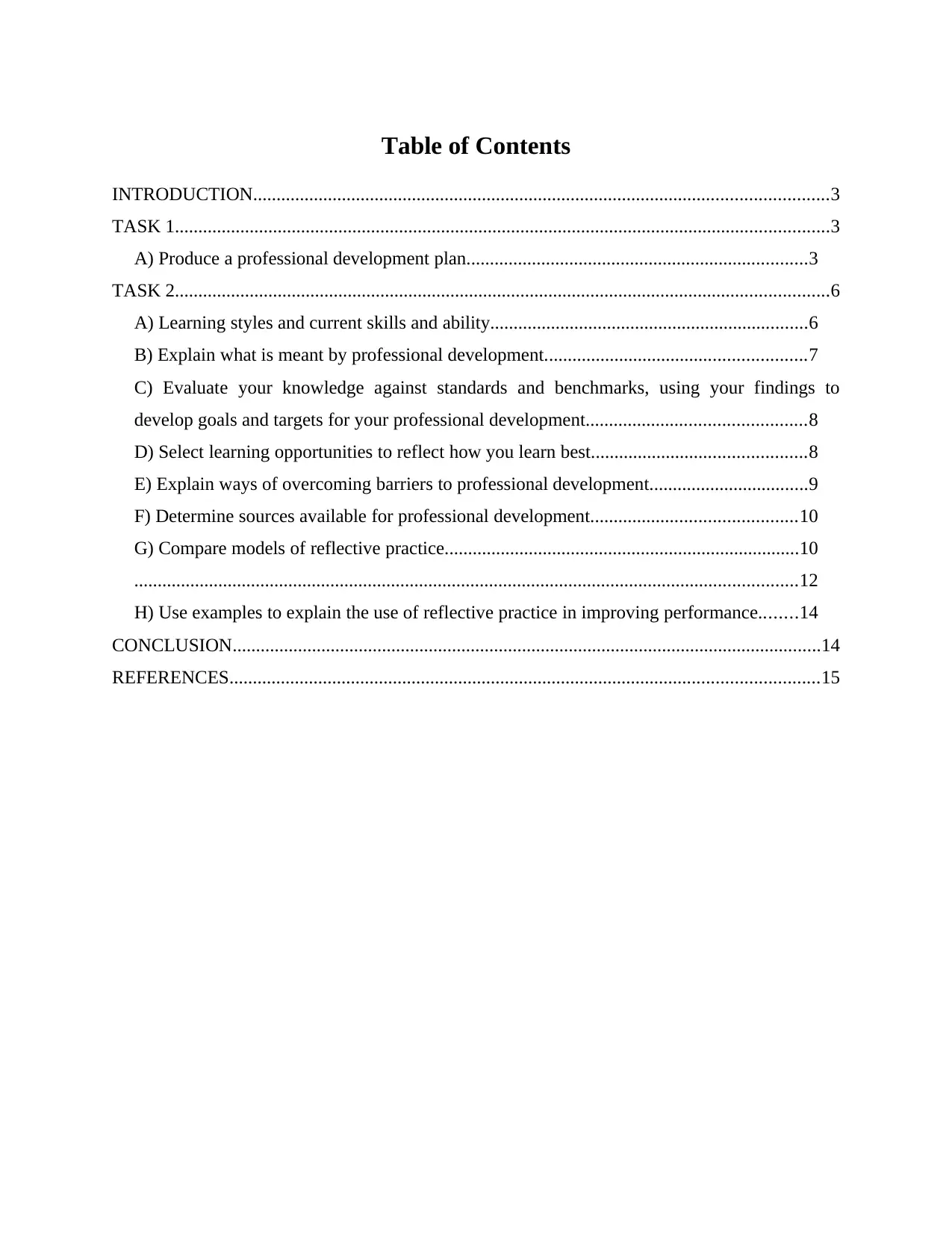
Table of Contents
INTRODUCTION...........................................................................................................................3
TASK 1............................................................................................................................................3
A) Produce a professional development plan.........................................................................3
TASK 2............................................................................................................................................6
A) Learning styles and current skills and ability....................................................................6
B) Explain what is meant by professional development........................................................7
C) Evaluate your knowledge against standards and benchmarks, using your findings to
develop goals and targets for your professional development...............................................8
D) Select learning opportunities to reflect how you learn best..............................................8
E) Explain ways of overcoming barriers to professional development..................................9
F) Determine sources available for professional development............................................10
G) Compare models of reflective practice............................................................................10
..............................................................................................................................................12
H) Use examples to explain the use of reflective practice in improving performance........14
CONCLUSION..............................................................................................................................14
REFERENCES..............................................................................................................................15
INTRODUCTION...........................................................................................................................3
TASK 1............................................................................................................................................3
A) Produce a professional development plan.........................................................................3
TASK 2............................................................................................................................................6
A) Learning styles and current skills and ability....................................................................6
B) Explain what is meant by professional development........................................................7
C) Evaluate your knowledge against standards and benchmarks, using your findings to
develop goals and targets for your professional development...............................................8
D) Select learning opportunities to reflect how you learn best..............................................8
E) Explain ways of overcoming barriers to professional development..................................9
F) Determine sources available for professional development............................................10
G) Compare models of reflective practice............................................................................10
..............................................................................................................................................12
H) Use examples to explain the use of reflective practice in improving performance........14
CONCLUSION..............................................................................................................................14
REFERENCES..............................................................................................................................15
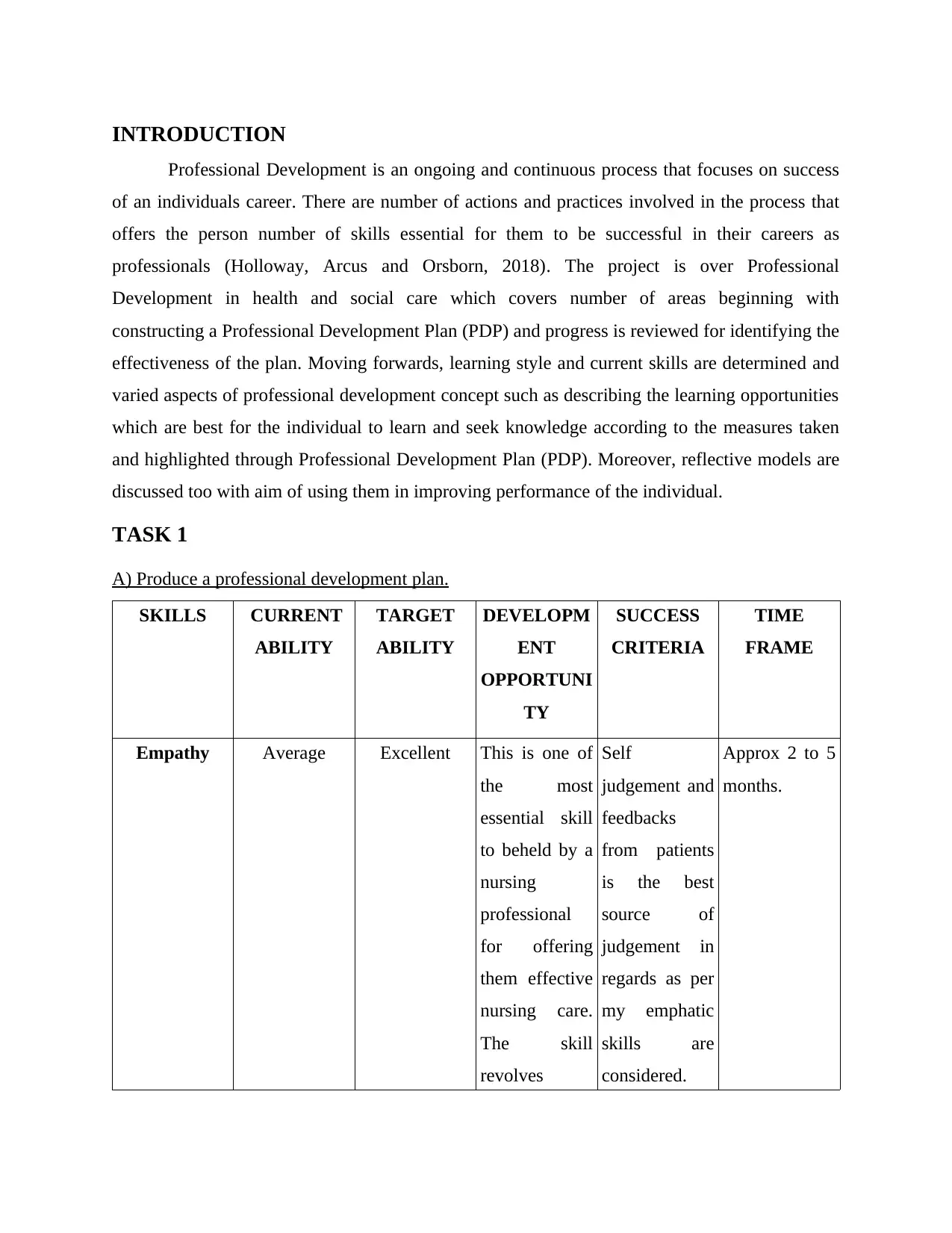
INTRODUCTION
Professional Development is an ongoing and continuous process that focuses on success
of an individuals career. There are number of actions and practices involved in the process that
offers the person number of skills essential for them to be successful in their careers as
professionals (Holloway, Arcus and Orsborn, 2018). The project is over Professional
Development in health and social care which covers number of areas beginning with
constructing a Professional Development Plan (PDP) and progress is reviewed for identifying the
effectiveness of the plan. Moving forwards, learning style and current skills are determined and
varied aspects of professional development concept such as describing the learning opportunities
which are best for the individual to learn and seek knowledge according to the measures taken
and highlighted through Professional Development Plan (PDP). Moreover, reflective models are
discussed too with aim of using them in improving performance of the individual.
TASK 1
A) Produce a professional development plan.
SKILLS CURRENT
ABILITY
TARGET
ABILITY
DEVELOPM
ENT
OPPORTUNI
TY
SUCCESS
CRITERIA
TIME
FRAME
Empathy Average Excellent This is one of
the most
essential skill
to beheld by a
nursing
professional
for offering
them effective
nursing care.
The skill
revolves
Self
judgement and
feedbacks
from patients
is the best
source of
judgement in
regards as per
my emphatic
skills are
considered.
Approx 2 to 5
months.
Professional Development is an ongoing and continuous process that focuses on success
of an individuals career. There are number of actions and practices involved in the process that
offers the person number of skills essential for them to be successful in their careers as
professionals (Holloway, Arcus and Orsborn, 2018). The project is over Professional
Development in health and social care which covers number of areas beginning with
constructing a Professional Development Plan (PDP) and progress is reviewed for identifying the
effectiveness of the plan. Moving forwards, learning style and current skills are determined and
varied aspects of professional development concept such as describing the learning opportunities
which are best for the individual to learn and seek knowledge according to the measures taken
and highlighted through Professional Development Plan (PDP). Moreover, reflective models are
discussed too with aim of using them in improving performance of the individual.
TASK 1
A) Produce a professional development plan.
SKILLS CURRENT
ABILITY
TARGET
ABILITY
DEVELOPM
ENT
OPPORTUNI
TY
SUCCESS
CRITERIA
TIME
FRAME
Empathy Average Excellent This is one of
the most
essential skill
to beheld by a
nursing
professional
for offering
them effective
nursing care.
The skill
revolves
Self
judgement and
feedbacks
from patients
is the best
source of
judgement in
regards as per
my emphatic
skills are
considered.
Approx 2 to 5
months.
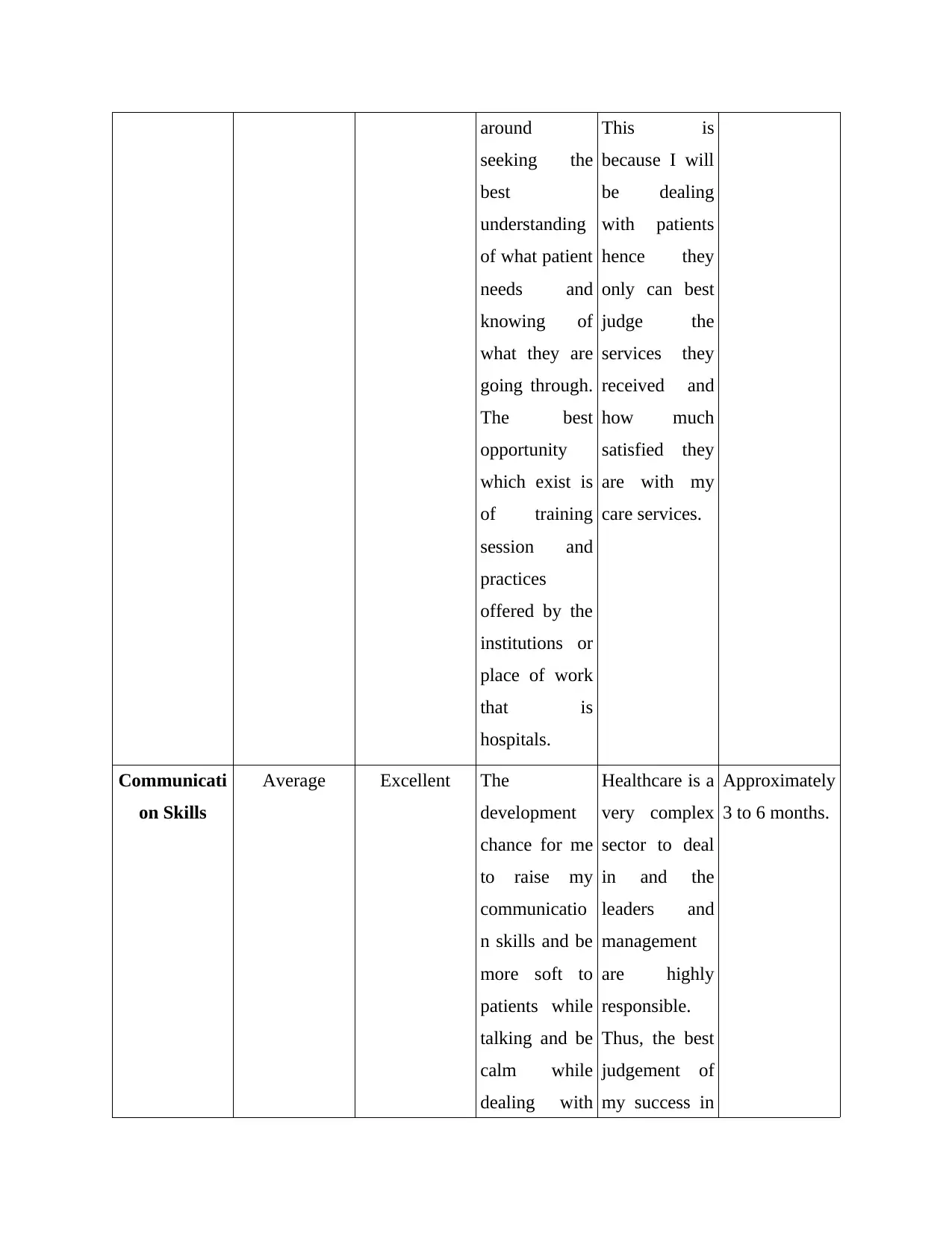
around
seeking the
best
understanding
of what patient
needs and
knowing of
what they are
going through.
The best
opportunity
which exist is
of training
session and
practices
offered by the
institutions or
place of work
that is
hospitals.
This is
because I will
be dealing
with patients
hence they
only can best
judge the
services they
received and
how much
satisfied they
are with my
care services.
Communicati
on Skills
Average Excellent The
development
chance for me
to raise my
communicatio
n skills and be
more soft to
patients while
talking and be
calm while
dealing with
Healthcare is a
very complex
sector to deal
in and the
leaders and
management
are highly
responsible.
Thus, the best
judgement of
my success in
Approximately
3 to 6 months.
seeking the
best
understanding
of what patient
needs and
knowing of
what they are
going through.
The best
opportunity
which exist is
of training
session and
practices
offered by the
institutions or
place of work
that is
hospitals.
This is
because I will
be dealing
with patients
hence they
only can best
judge the
services they
received and
how much
satisfied they
are with my
care services.
Communicati
on Skills
Average Excellent The
development
chance for me
to raise my
communicatio
n skills and be
more soft to
patients while
talking and be
calm while
dealing with
Healthcare is a
very complex
sector to deal
in and the
leaders and
management
are highly
responsible.
Thus, the best
judgement of
my success in
Approximately
3 to 6 months.
Secure Best Marks with AI Grader
Need help grading? Try our AI Grader for instant feedback on your assignments.
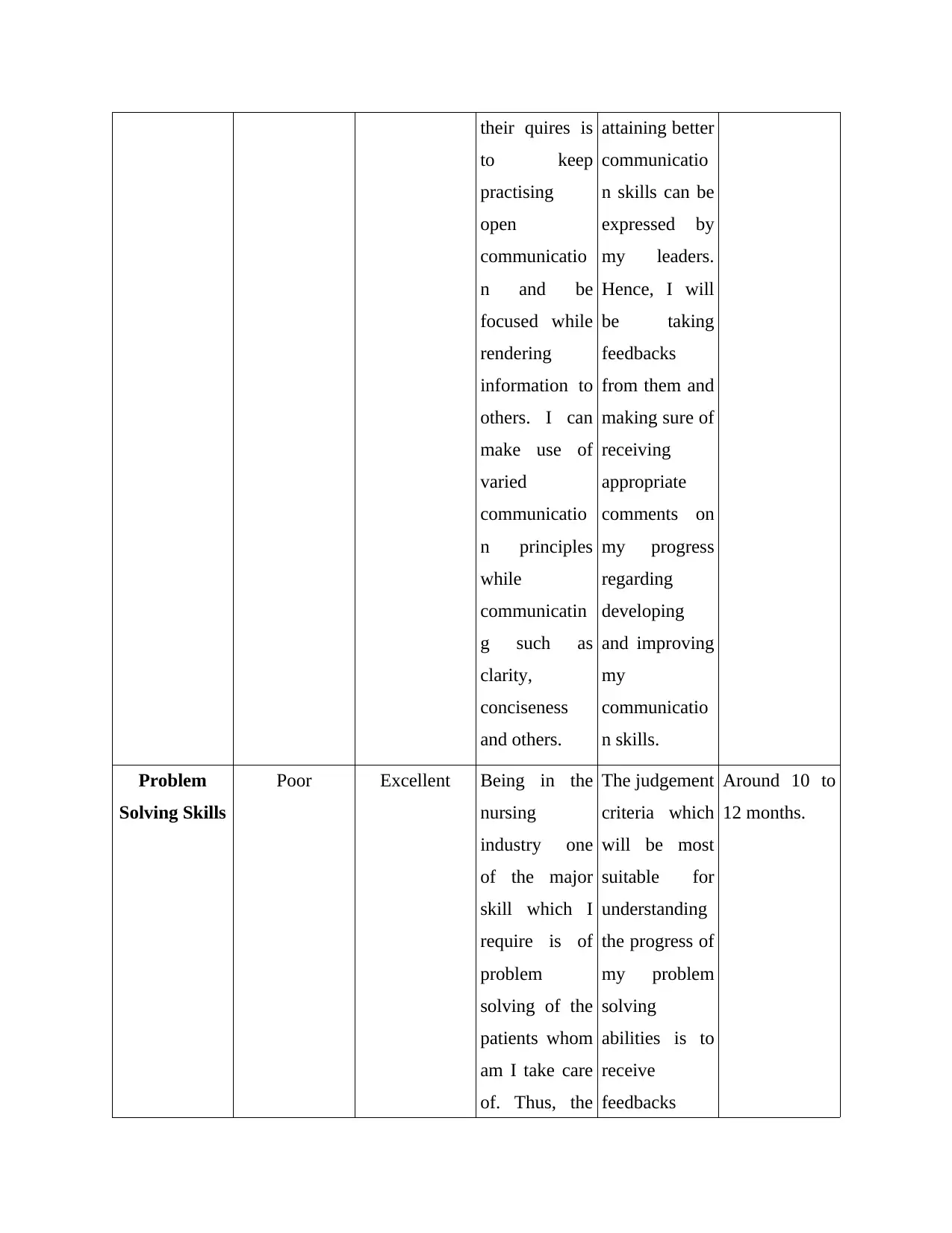
their quires is
to keep
practising
open
communicatio
n and be
focused while
rendering
information to
others. I can
make use of
varied
communicatio
n principles
while
communicatin
g such as
clarity,
conciseness
and others.
attaining better
communicatio
n skills can be
expressed by
my leaders.
Hence, I will
be taking
feedbacks
from them and
making sure of
receiving
appropriate
comments on
my progress
regarding
developing
and improving
my
communicatio
n skills.
Problem
Solving Skills
Poor Excellent Being in the
nursing
industry one
of the major
skill which I
require is of
problem
solving of the
patients whom
am I take care
of. Thus, the
The judgement
criteria which
will be most
suitable for
understanding
the progress of
my problem
solving
abilities is to
receive
feedbacks
Around 10 to
12 months.
to keep
practising
open
communicatio
n and be
focused while
rendering
information to
others. I can
make use of
varied
communicatio
n principles
while
communicatin
g such as
clarity,
conciseness
and others.
attaining better
communicatio
n skills can be
expressed by
my leaders.
Hence, I will
be taking
feedbacks
from them and
making sure of
receiving
appropriate
comments on
my progress
regarding
developing
and improving
my
communicatio
n skills.
Problem
Solving Skills
Poor Excellent Being in the
nursing
industry one
of the major
skill which I
require is of
problem
solving of the
patients whom
am I take care
of. Thus, the
The judgement
criteria which
will be most
suitable for
understanding
the progress of
my problem
solving
abilities is to
receive
feedbacks
Around 10 to
12 months.
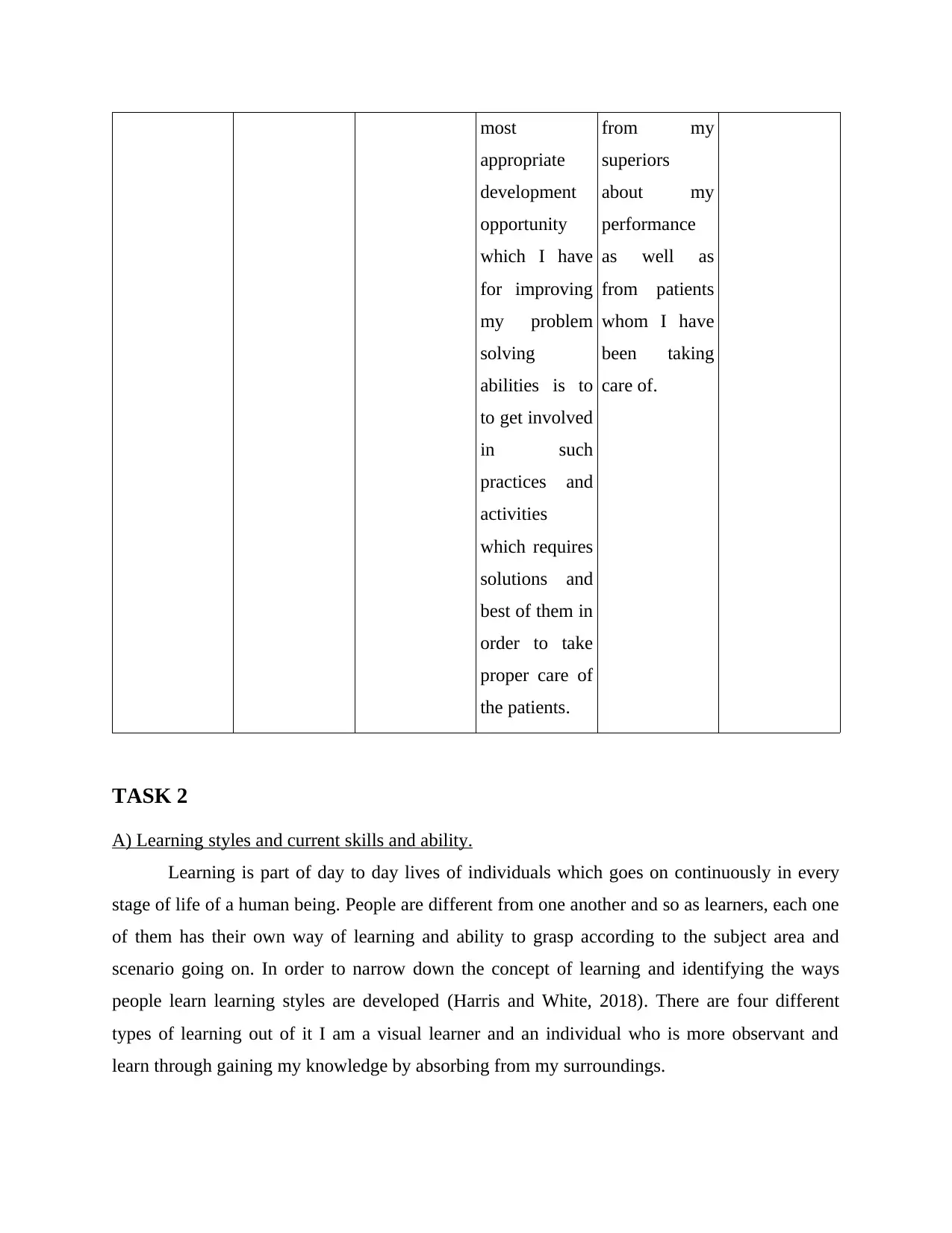
most
appropriate
development
opportunity
which I have
for improving
my problem
solving
abilities is to
to get involved
in such
practices and
activities
which requires
solutions and
best of them in
order to take
proper care of
the patients.
from my
superiors
about my
performance
as well as
from patients
whom I have
been taking
care of.
TASK 2
A) Learning styles and current skills and ability.
Learning is part of day to day lives of individuals which goes on continuously in every
stage of life of a human being. People are different from one another and so as learners, each one
of them has their own way of learning and ability to grasp according to the subject area and
scenario going on. In order to narrow down the concept of learning and identifying the ways
people learn learning styles are developed (Harris and White, 2018). There are four different
types of learning out of it I am a visual learner and an individual who is more observant and
learn through gaining my knowledge by absorbing from my surroundings.
appropriate
development
opportunity
which I have
for improving
my problem
solving
abilities is to
to get involved
in such
practices and
activities
which requires
solutions and
best of them in
order to take
proper care of
the patients.
from my
superiors
about my
performance
as well as
from patients
whom I have
been taking
care of.
TASK 2
A) Learning styles and current skills and ability.
Learning is part of day to day lives of individuals which goes on continuously in every
stage of life of a human being. People are different from one another and so as learners, each one
of them has their own way of learning and ability to grasp according to the subject area and
scenario going on. In order to narrow down the concept of learning and identifying the ways
people learn learning styles are developed (Harris and White, 2018). There are four different
types of learning out of it I am a visual learner and an individual who is more observant and
learn through gaining my knowledge by absorbing from my surroundings.
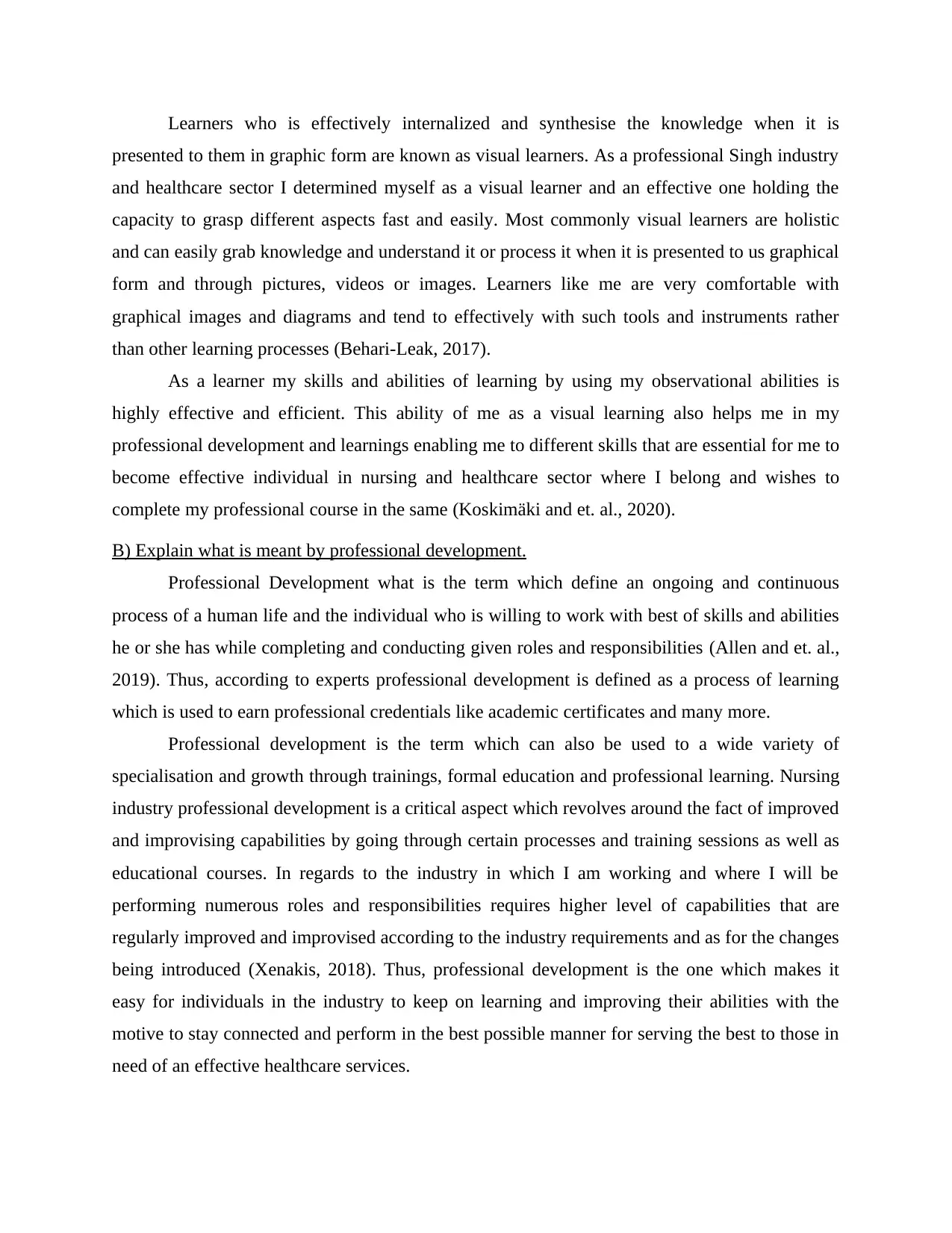
Learners who is effectively internalized and synthesise the knowledge when it is
presented to them in graphic form are known as visual learners. As a professional Singh industry
and healthcare sector I determined myself as a visual learner and an effective one holding the
capacity to grasp different aspects fast and easily. Most commonly visual learners are holistic
and can easily grab knowledge and understand it or process it when it is presented to us graphical
form and through pictures, videos or images. Learners like me are very comfortable with
graphical images and diagrams and tend to effectively with such tools and instruments rather
than other learning processes (Behari-Leak, 2017).
As a learner my skills and abilities of learning by using my observational abilities is
highly effective and efficient. This ability of me as a visual learning also helps me in my
professional development and learnings enabling me to different skills that are essential for me to
become effective individual in nursing and healthcare sector where I belong and wishes to
complete my professional course in the same (Koskimäki and et. al., 2020).
B) Explain what is meant by professional development.
Professional Development what is the term which define an ongoing and continuous
process of a human life and the individual who is willing to work with best of skills and abilities
he or she has while completing and conducting given roles and responsibilities (Allen and et. al.,
2019). Thus, according to experts professional development is defined as a process of learning
which is used to earn professional credentials like academic certificates and many more.
Professional development is the term which can also be used to a wide variety of
specialisation and growth through trainings, formal education and professional learning. Nursing
industry professional development is a critical aspect which revolves around the fact of improved
and improvising capabilities by going through certain processes and training sessions as well as
educational courses. In regards to the industry in which I am working and where I will be
performing numerous roles and responsibilities requires higher level of capabilities that are
regularly improved and improvised according to the industry requirements and as for the changes
being introduced (Xenakis, 2018). Thus, professional development is the one which makes it
easy for individuals in the industry to keep on learning and improving their abilities with the
motive to stay connected and perform in the best possible manner for serving the best to those in
need of an effective healthcare services.
presented to them in graphic form are known as visual learners. As a professional Singh industry
and healthcare sector I determined myself as a visual learner and an effective one holding the
capacity to grasp different aspects fast and easily. Most commonly visual learners are holistic
and can easily grab knowledge and understand it or process it when it is presented to us graphical
form and through pictures, videos or images. Learners like me are very comfortable with
graphical images and diagrams and tend to effectively with such tools and instruments rather
than other learning processes (Behari-Leak, 2017).
As a learner my skills and abilities of learning by using my observational abilities is
highly effective and efficient. This ability of me as a visual learning also helps me in my
professional development and learnings enabling me to different skills that are essential for me to
become effective individual in nursing and healthcare sector where I belong and wishes to
complete my professional course in the same (Koskimäki and et. al., 2020).
B) Explain what is meant by professional development.
Professional Development what is the term which define an ongoing and continuous
process of a human life and the individual who is willing to work with best of skills and abilities
he or she has while completing and conducting given roles and responsibilities (Allen and et. al.,
2019). Thus, according to experts professional development is defined as a process of learning
which is used to earn professional credentials like academic certificates and many more.
Professional development is the term which can also be used to a wide variety of
specialisation and growth through trainings, formal education and professional learning. Nursing
industry professional development is a critical aspect which revolves around the fact of improved
and improvising capabilities by going through certain processes and training sessions as well as
educational courses. In regards to the industry in which I am working and where I will be
performing numerous roles and responsibilities requires higher level of capabilities that are
regularly improved and improvised according to the industry requirements and as for the changes
being introduced (Xenakis, 2018). Thus, professional development is the one which makes it
easy for individuals in the industry to keep on learning and improving their abilities with the
motive to stay connected and perform in the best possible manner for serving the best to those in
need of an effective healthcare services.
Paraphrase This Document
Need a fresh take? Get an instant paraphrase of this document with our AI Paraphraser
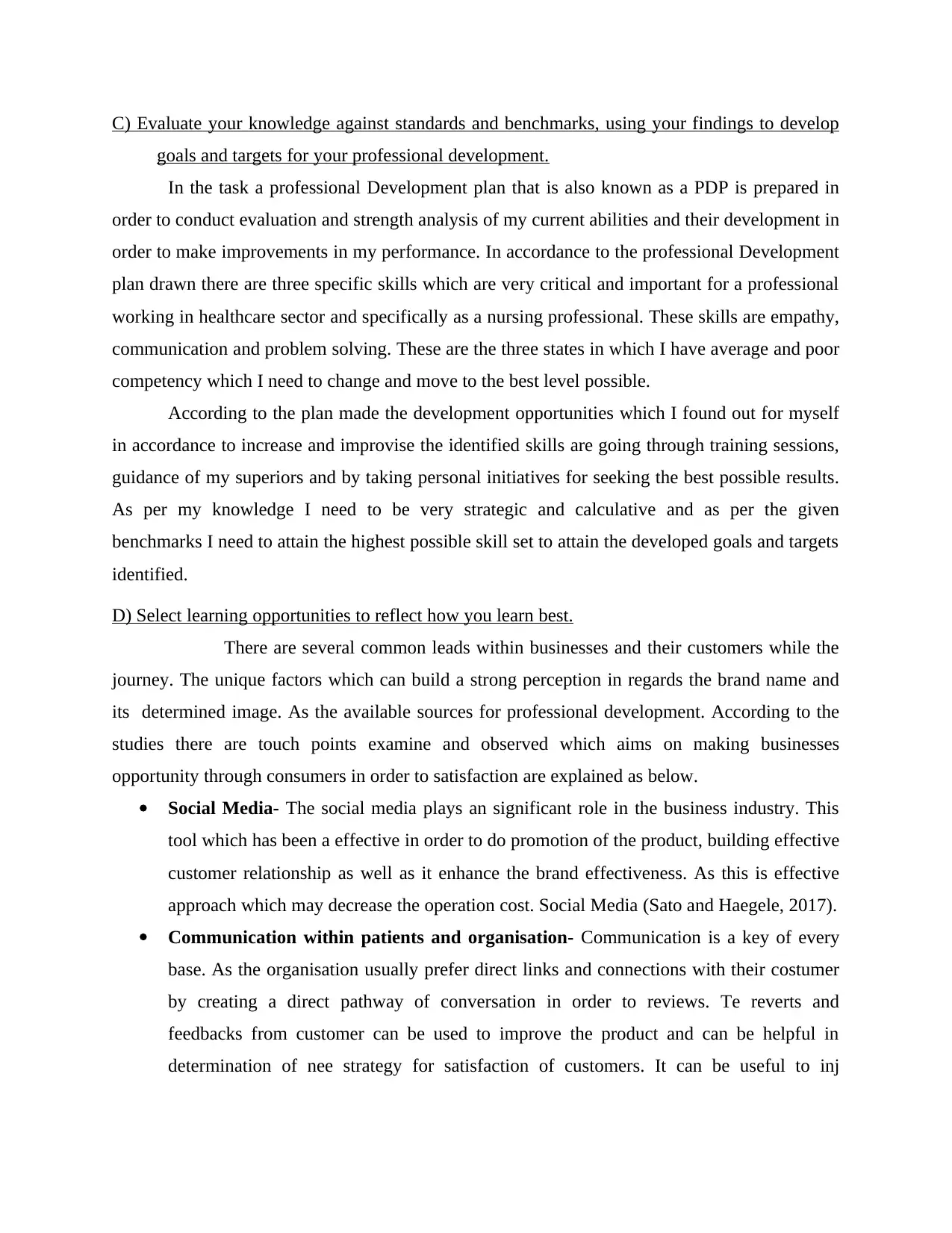
C) Evaluate your knowledge against standards and benchmarks, using your findings to develop
goals and targets for your professional development.
In the task a professional Development plan that is also known as a PDP is prepared in
order to conduct evaluation and strength analysis of my current abilities and their development in
order to make improvements in my performance. In accordance to the professional Development
plan drawn there are three specific skills which are very critical and important for a professional
working in healthcare sector and specifically as a nursing professional. These skills are empathy,
communication and problem solving. These are the three states in which I have average and poor
competency which I need to change and move to the best level possible.
According to the plan made the development opportunities which I found out for myself
in accordance to increase and improvise the identified skills are going through training sessions,
guidance of my superiors and by taking personal initiatives for seeking the best possible results.
As per my knowledge I need to be very strategic and calculative and as per the given
benchmarks I need to attain the highest possible skill set to attain the developed goals and targets
identified.
D) Select learning opportunities to reflect how you learn best.
There are several common leads within businesses and their customers while the
journey. The unique factors which can build a strong perception in regards the brand name and
its determined image. As the available sources for professional development. According to the
studies there are touch points examine and observed which aims on making businesses
opportunity through consumers in order to satisfaction are explained as below.
Social Media- The social media plays an significant role in the business industry. This
tool which has been a effective in order to do promotion of the product, building effective
customer relationship as well as it enhance the brand effectiveness. As this is effective
approach which may decrease the operation cost. Social Media (Sato and Haegele, 2017).
Communication within patients and organisation- Communication is a key of every
base. As the organisation usually prefer direct links and connections with their costumer
by creating a direct pathway of conversation in order to reviews. Te reverts and
feedbacks from customer can be used to improve the product and can be helpful in
determination of nee strategy for satisfaction of customers. It can be useful to inj
goals and targets for your professional development.
In the task a professional Development plan that is also known as a PDP is prepared in
order to conduct evaluation and strength analysis of my current abilities and their development in
order to make improvements in my performance. In accordance to the professional Development
plan drawn there are three specific skills which are very critical and important for a professional
working in healthcare sector and specifically as a nursing professional. These skills are empathy,
communication and problem solving. These are the three states in which I have average and poor
competency which I need to change and move to the best level possible.
According to the plan made the development opportunities which I found out for myself
in accordance to increase and improvise the identified skills are going through training sessions,
guidance of my superiors and by taking personal initiatives for seeking the best possible results.
As per my knowledge I need to be very strategic and calculative and as per the given
benchmarks I need to attain the highest possible skill set to attain the developed goals and targets
identified.
D) Select learning opportunities to reflect how you learn best.
There are several common leads within businesses and their customers while the
journey. The unique factors which can build a strong perception in regards the brand name and
its determined image. As the available sources for professional development. According to the
studies there are touch points examine and observed which aims on making businesses
opportunity through consumers in order to satisfaction are explained as below.
Social Media- The social media plays an significant role in the business industry. This
tool which has been a effective in order to do promotion of the product, building effective
customer relationship as well as it enhance the brand effectiveness. As this is effective
approach which may decrease the operation cost. Social Media (Sato and Haegele, 2017).
Communication within patients and organisation- Communication is a key of every
base. As the organisation usually prefer direct links and connections with their costumer
by creating a direct pathway of conversation in order to reviews. Te reverts and
feedbacks from customer can be used to improve the product and can be helpful in
determination of nee strategy for satisfaction of customers. It can be useful to inj
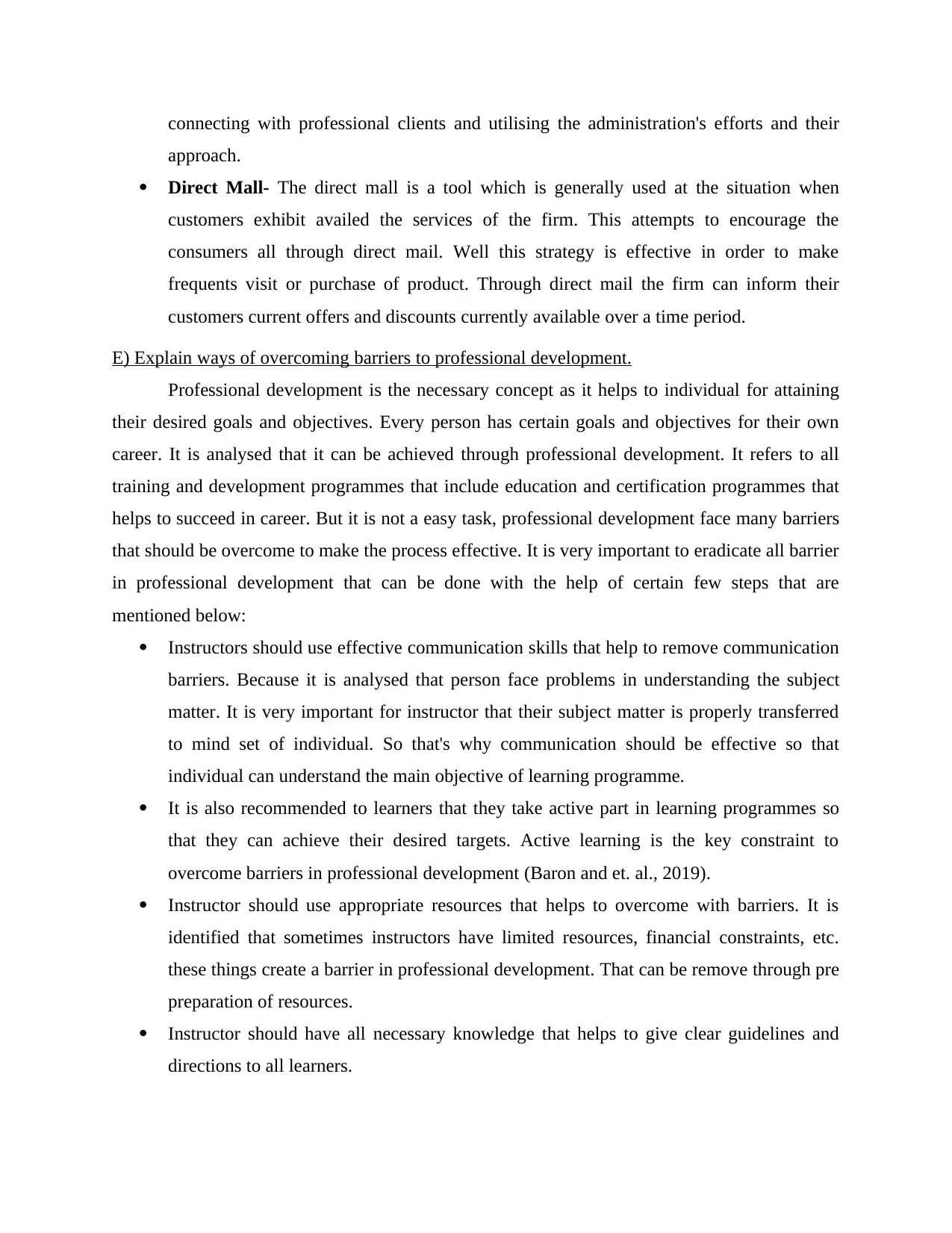
connecting with professional clients and utilising the administration's efforts and their
approach.
Direct Mall- The direct mall is a tool which is generally used at the situation when
customers exhibit availed the services of the firm. This attempts to encourage the
consumers all through direct mail. Well this strategy is effective in order to make
frequents visit or purchase of product. Through direct mail the firm can inform their
customers current offers and discounts currently available over a time period.
E) Explain ways of overcoming barriers to professional development.
Professional development is the necessary concept as it helps to individual for attaining
their desired goals and objectives. Every person has certain goals and objectives for their own
career. It is analysed that it can be achieved through professional development. It refers to all
training and development programmes that include education and certification programmes that
helps to succeed in career. But it is not a easy task, professional development face many barriers
that should be overcome to make the process effective. It is very important to eradicate all barrier
in professional development that can be done with the help of certain few steps that are
mentioned below:
Instructors should use effective communication skills that help to remove communication
barriers. Because it is analysed that person face problems in understanding the subject
matter. It is very important for instructor that their subject matter is properly transferred
to mind set of individual. So that's why communication should be effective so that
individual can understand the main objective of learning programme.
It is also recommended to learners that they take active part in learning programmes so
that they can achieve their desired targets. Active learning is the key constraint to
overcome barriers in professional development (Baron and et. al., 2019).
Instructor should use appropriate resources that helps to overcome with barriers. It is
identified that sometimes instructors have limited resources, financial constraints, etc.
these things create a barrier in professional development. That can be remove through pre
preparation of resources.
Instructor should have all necessary knowledge that helps to give clear guidelines and
directions to all learners.
approach.
Direct Mall- The direct mall is a tool which is generally used at the situation when
customers exhibit availed the services of the firm. This attempts to encourage the
consumers all through direct mail. Well this strategy is effective in order to make
frequents visit or purchase of product. Through direct mail the firm can inform their
customers current offers and discounts currently available over a time period.
E) Explain ways of overcoming barriers to professional development.
Professional development is the necessary concept as it helps to individual for attaining
their desired goals and objectives. Every person has certain goals and objectives for their own
career. It is analysed that it can be achieved through professional development. It refers to all
training and development programmes that include education and certification programmes that
helps to succeed in career. But it is not a easy task, professional development face many barriers
that should be overcome to make the process effective. It is very important to eradicate all barrier
in professional development that can be done with the help of certain few steps that are
mentioned below:
Instructors should use effective communication skills that help to remove communication
barriers. Because it is analysed that person face problems in understanding the subject
matter. It is very important for instructor that their subject matter is properly transferred
to mind set of individual. So that's why communication should be effective so that
individual can understand the main objective of learning programme.
It is also recommended to learners that they take active part in learning programmes so
that they can achieve their desired targets. Active learning is the key constraint to
overcome barriers in professional development (Baron and et. al., 2019).
Instructor should use appropriate resources that helps to overcome with barriers. It is
identified that sometimes instructors have limited resources, financial constraints, etc.
these things create a barrier in professional development. That can be remove through pre
preparation of resources.
Instructor should have all necessary knowledge that helps to give clear guidelines and
directions to all learners.
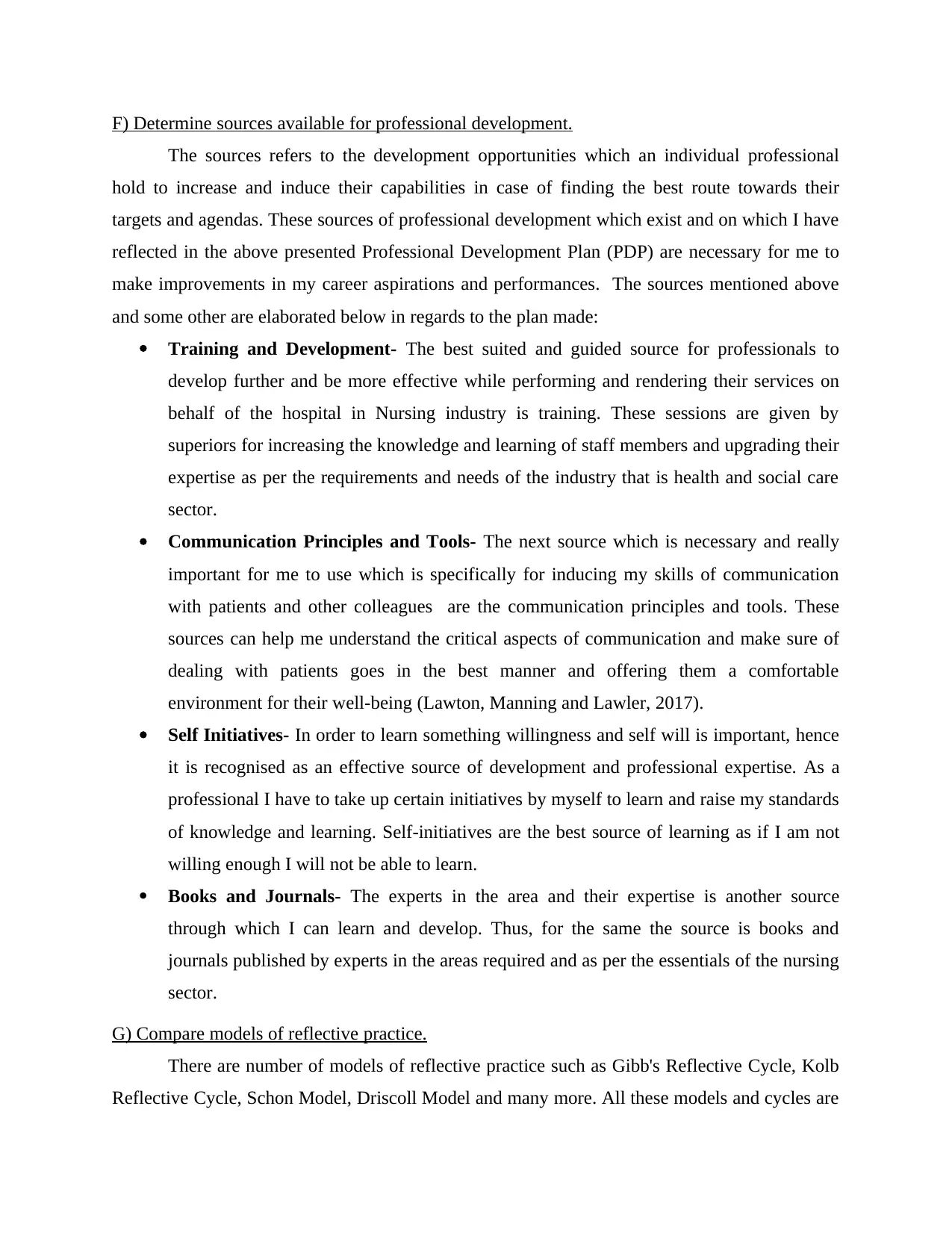
F) Determine sources available for professional development.
The sources refers to the development opportunities which an individual professional
hold to increase and induce their capabilities in case of finding the best route towards their
targets and agendas. These sources of professional development which exist and on which I have
reflected in the above presented Professional Development Plan (PDP) are necessary for me to
make improvements in my career aspirations and performances. The sources mentioned above
and some other are elaborated below in regards to the plan made:
Training and Development- The best suited and guided source for professionals to
develop further and be more effective while performing and rendering their services on
behalf of the hospital in Nursing industry is training. These sessions are given by
superiors for increasing the knowledge and learning of staff members and upgrading their
expertise as per the requirements and needs of the industry that is health and social care
sector.
Communication Principles and Tools- The next source which is necessary and really
important for me to use which is specifically for inducing my skills of communication
with patients and other colleagues are the communication principles and tools. These
sources can help me understand the critical aspects of communication and make sure of
dealing with patients goes in the best manner and offering them a comfortable
environment for their well-being (Lawton, Manning and Lawler, 2017).
Self Initiatives- In order to learn something willingness and self will is important, hence
it is recognised as an effective source of development and professional expertise. As a
professional I have to take up certain initiatives by myself to learn and raise my standards
of knowledge and learning. Self-initiatives are the best source of learning as if I am not
willing enough I will not be able to learn.
Books and Journals- The experts in the area and their expertise is another source
through which I can learn and develop. Thus, for the same the source is books and
journals published by experts in the areas required and as per the essentials of the nursing
sector.
G) Compare models of reflective practice.
There are number of models of reflective practice such as Gibb's Reflective Cycle, Kolb
Reflective Cycle, Schon Model, Driscoll Model and many more. All these models and cycles are
The sources refers to the development opportunities which an individual professional
hold to increase and induce their capabilities in case of finding the best route towards their
targets and agendas. These sources of professional development which exist and on which I have
reflected in the above presented Professional Development Plan (PDP) are necessary for me to
make improvements in my career aspirations and performances. The sources mentioned above
and some other are elaborated below in regards to the plan made:
Training and Development- The best suited and guided source for professionals to
develop further and be more effective while performing and rendering their services on
behalf of the hospital in Nursing industry is training. These sessions are given by
superiors for increasing the knowledge and learning of staff members and upgrading their
expertise as per the requirements and needs of the industry that is health and social care
sector.
Communication Principles and Tools- The next source which is necessary and really
important for me to use which is specifically for inducing my skills of communication
with patients and other colleagues are the communication principles and tools. These
sources can help me understand the critical aspects of communication and make sure of
dealing with patients goes in the best manner and offering them a comfortable
environment for their well-being (Lawton, Manning and Lawler, 2017).
Self Initiatives- In order to learn something willingness and self will is important, hence
it is recognised as an effective source of development and professional expertise. As a
professional I have to take up certain initiatives by myself to learn and raise my standards
of knowledge and learning. Self-initiatives are the best source of learning as if I am not
willing enough I will not be able to learn.
Books and Journals- The experts in the area and their expertise is another source
through which I can learn and develop. Thus, for the same the source is books and
journals published by experts in the areas required and as per the essentials of the nursing
sector.
G) Compare models of reflective practice.
There are number of models of reflective practice such as Gibb's Reflective Cycle, Kolb
Reflective Cycle, Schon Model, Driscoll Model and many more. All these models and cycles are
Secure Best Marks with AI Grader
Need help grading? Try our AI Grader for instant feedback on your assignments.
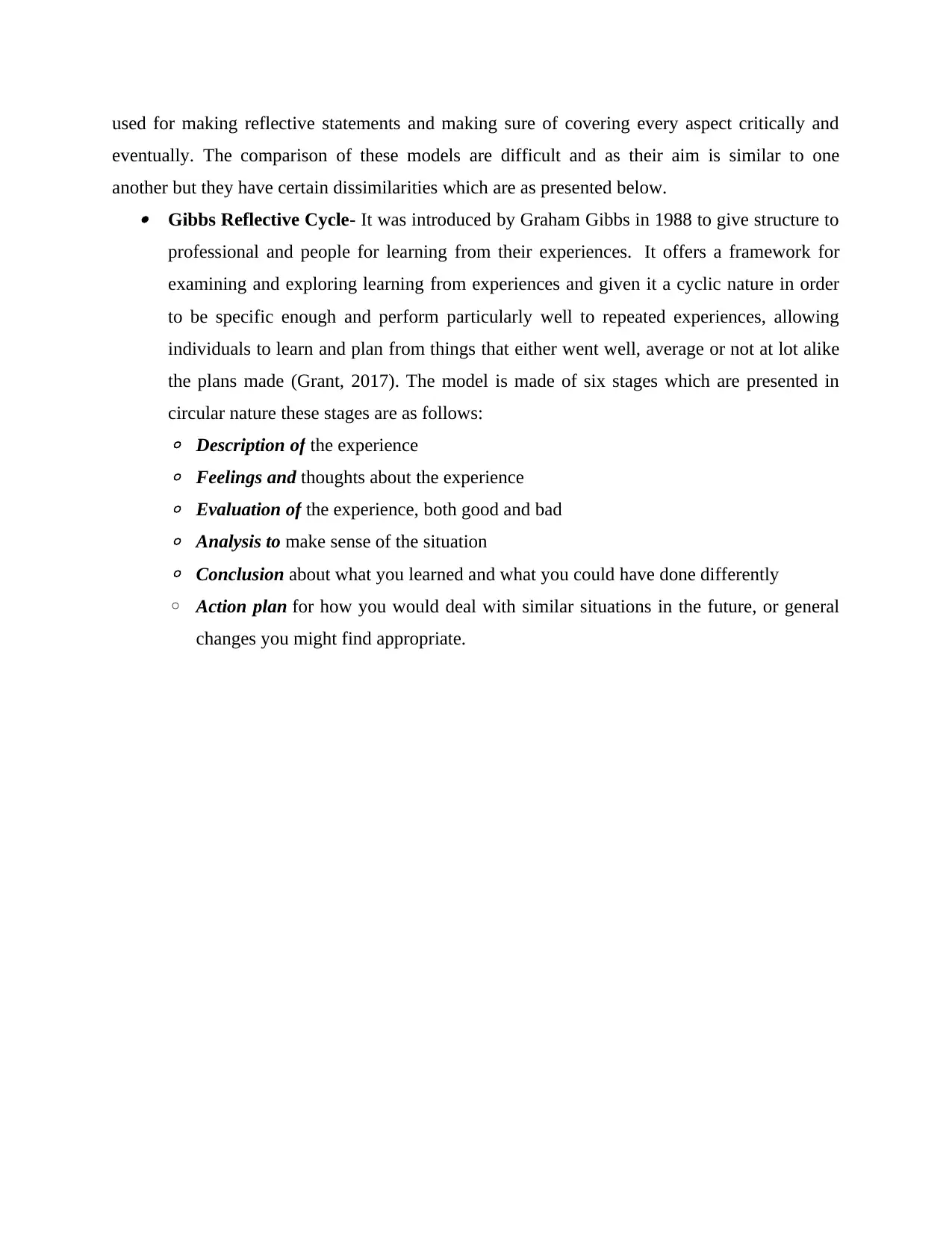
used for making reflective statements and making sure of covering every aspect critically and
eventually. The comparison of these models are difficult and as their aim is similar to one
another but they have certain dissimilarities which are as presented below. Gibbs Reflective Cycle- It was introduced by Graham Gibbs in 1988 to give structure to
professional and people for learning from their experiences. It offers a framework for
examining and exploring learning from experiences and given it a cyclic nature in order
to be specific enough and perform particularly well to repeated experiences, allowing
individuals to learn and plan from things that either went well, average or not at lot alike
the plans made (Grant, 2017). The model is made of six stages which are presented in
circular nature these stages are as follows:
◦ Description of the experience
◦ Feelings and thoughts about the experience
◦ Evaluation of the experience, both good and bad
◦ Analysis to make sense of the situation
◦ Conclusion about what you learned and what you could have done differently
◦ Action plan for how you would deal with similar situations in the future, or general
changes you might find appropriate.
eventually. The comparison of these models are difficult and as their aim is similar to one
another but they have certain dissimilarities which are as presented below. Gibbs Reflective Cycle- It was introduced by Graham Gibbs in 1988 to give structure to
professional and people for learning from their experiences. It offers a framework for
examining and exploring learning from experiences and given it a cyclic nature in order
to be specific enough and perform particularly well to repeated experiences, allowing
individuals to learn and plan from things that either went well, average or not at lot alike
the plans made (Grant, 2017). The model is made of six stages which are presented in
circular nature these stages are as follows:
◦ Description of the experience
◦ Feelings and thoughts about the experience
◦ Evaluation of the experience, both good and bad
◦ Analysis to make sense of the situation
◦ Conclusion about what you learned and what you could have done differently
◦ Action plan for how you would deal with similar situations in the future, or general
changes you might find appropriate.
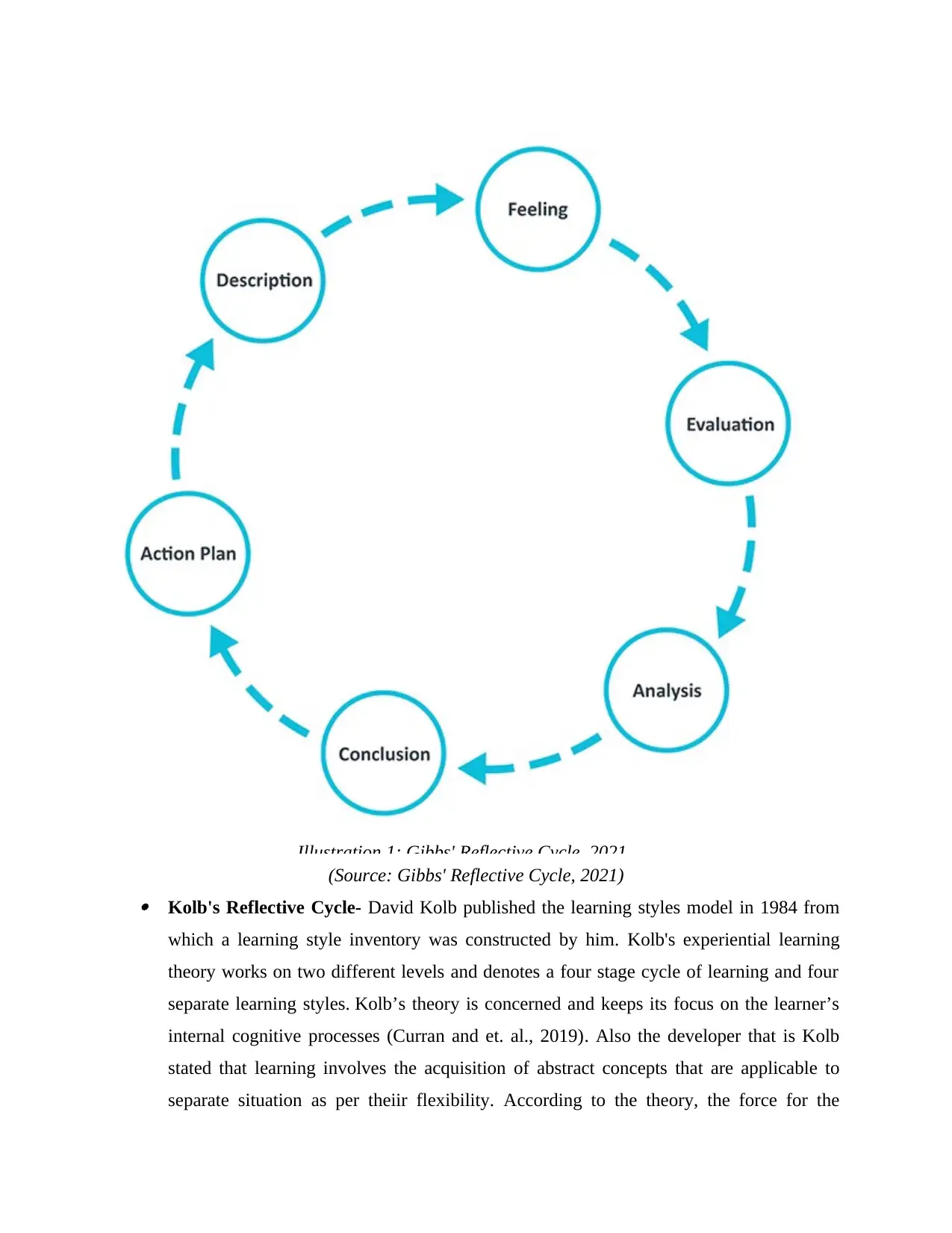
Illustration 1: Gibbs' Reflective Cycle, 2021
(Source: Gibbs' Reflective Cycle, 2021) Kolb's Reflective Cycle- David Kolb published the learning styles model in 1984 from
which a learning style inventory was constructed by him. Kolb's experiential learning
theory works on two different levels and denotes a four stage cycle of learning and four
separate learning styles. Kolb’s theory is concerned and keeps its focus on the learner’s
internal cognitive processes (Curran and et. al., 2019). Also the developer that is Kolb
stated that learning involves the acquisition of abstract concepts that are applicable to
separate situation as per theiir flexibility. According to the theory, the force for the
(Source: Gibbs' Reflective Cycle, 2021) Kolb's Reflective Cycle- David Kolb published the learning styles model in 1984 from
which a learning style inventory was constructed by him. Kolb's experiential learning
theory works on two different levels and denotes a four stage cycle of learning and four
separate learning styles. Kolb’s theory is concerned and keeps its focus on the learner’s
internal cognitive processes (Curran and et. al., 2019). Also the developer that is Kolb
stated that learning involves the acquisition of abstract concepts that are applicable to
separate situation as per theiir flexibility. According to the theory, the force for the
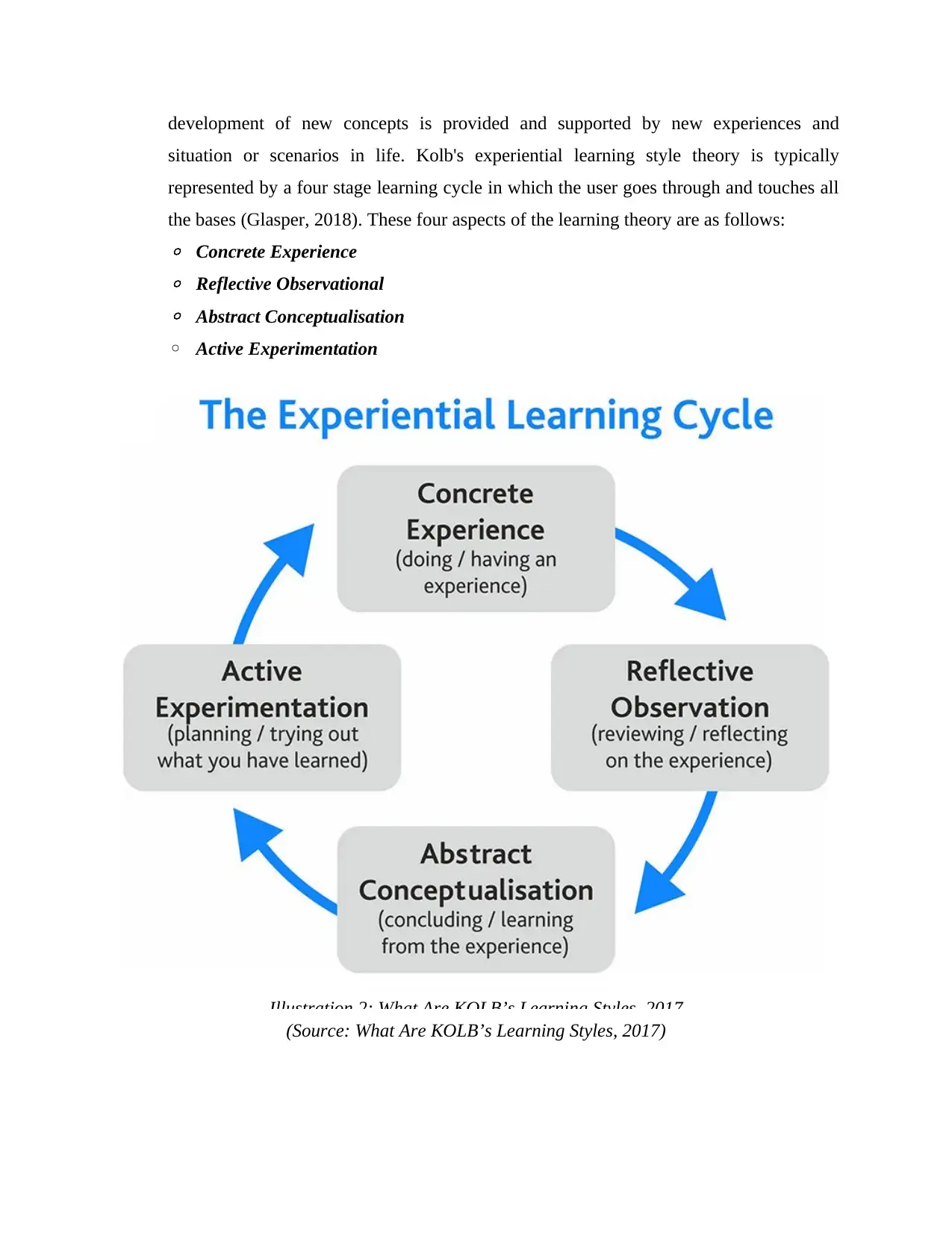
development of new concepts is provided and supported by new experiences and
situation or scenarios in life. Kolb's experiential learning style theory is typically
represented by a four stage learning cycle in which the user goes through and touches all
the bases (Glasper, 2018). These four aspects of the learning theory are as follows:
◦ Concrete Experience
◦ Reflective Observational
◦ Abstract Conceptualisation
◦ Active Experimentation
Illustration 2: What Are KOLB’s Learning Styles, 2017
(Source: What Are KOLB’s Learning Styles, 2017)
situation or scenarios in life. Kolb's experiential learning style theory is typically
represented by a four stage learning cycle in which the user goes through and touches all
the bases (Glasper, 2018). These four aspects of the learning theory are as follows:
◦ Concrete Experience
◦ Reflective Observational
◦ Abstract Conceptualisation
◦ Active Experimentation
Illustration 2: What Are KOLB’s Learning Styles, 2017
(Source: What Are KOLB’s Learning Styles, 2017)
Paraphrase This Document
Need a fresh take? Get an instant paraphrase of this document with our AI Paraphraser
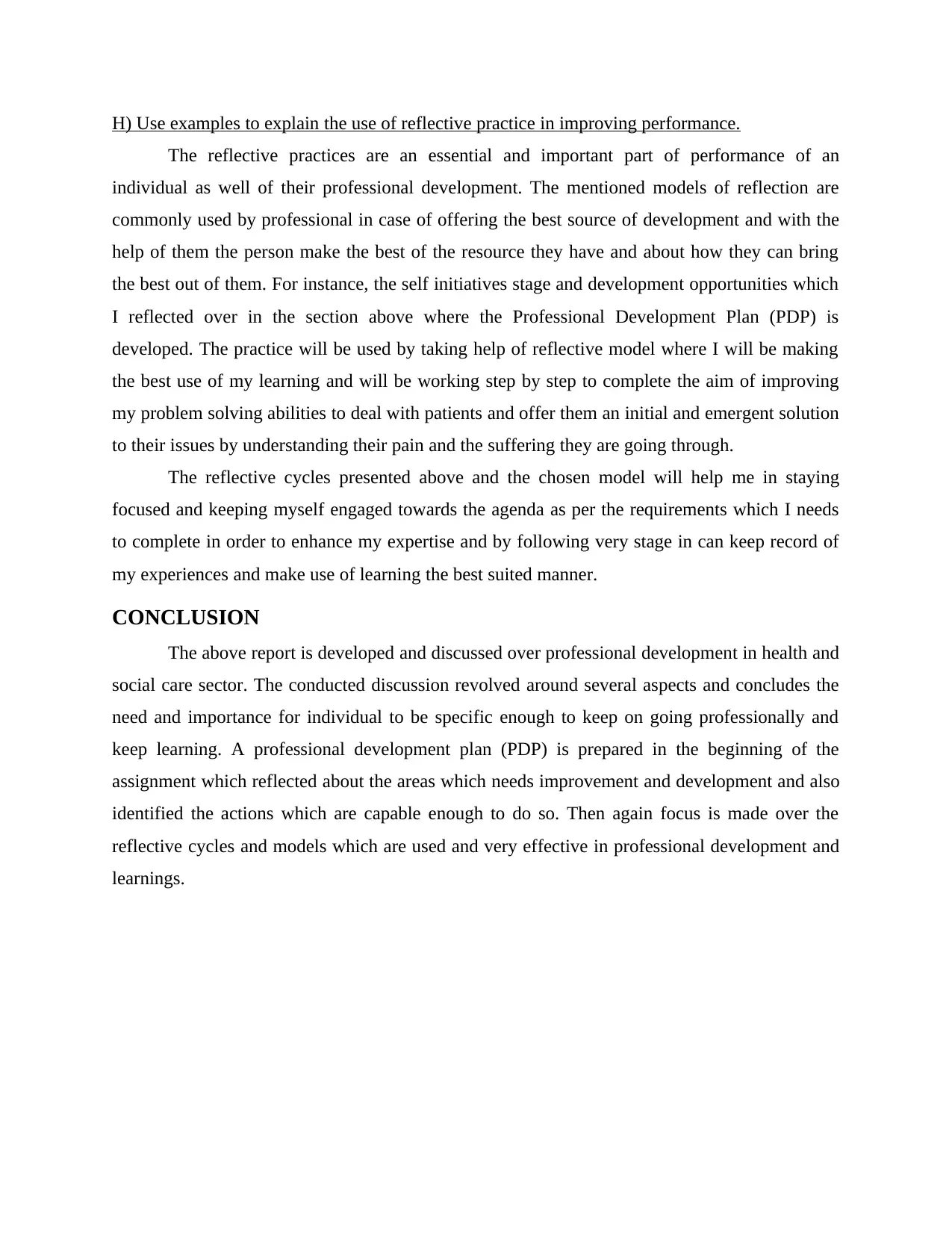
H) Use examples to explain the use of reflective practice in improving performance.
The reflective practices are an essential and important part of performance of an
individual as well of their professional development. The mentioned models of reflection are
commonly used by professional in case of offering the best source of development and with the
help of them the person make the best of the resource they have and about how they can bring
the best out of them. For instance, the self initiatives stage and development opportunities which
I reflected over in the section above where the Professional Development Plan (PDP) is
developed. The practice will be used by taking help of reflective model where I will be making
the best use of my learning and will be working step by step to complete the aim of improving
my problem solving abilities to deal with patients and offer them an initial and emergent solution
to their issues by understanding their pain and the suffering they are going through.
The reflective cycles presented above and the chosen model will help me in staying
focused and keeping myself engaged towards the agenda as per the requirements which I needs
to complete in order to enhance my expertise and by following very stage in can keep record of
my experiences and make use of learning the best suited manner.
CONCLUSION
The above report is developed and discussed over professional development in health and
social care sector. The conducted discussion revolved around several aspects and concludes the
need and importance for individual to be specific enough to keep on going professionally and
keep learning. A professional development plan (PDP) is prepared in the beginning of the
assignment which reflected about the areas which needs improvement and development and also
identified the actions which are capable enough to do so. Then again focus is made over the
reflective cycles and models which are used and very effective in professional development and
learnings.
The reflective practices are an essential and important part of performance of an
individual as well of their professional development. The mentioned models of reflection are
commonly used by professional in case of offering the best source of development and with the
help of them the person make the best of the resource they have and about how they can bring
the best out of them. For instance, the self initiatives stage and development opportunities which
I reflected over in the section above where the Professional Development Plan (PDP) is
developed. The practice will be used by taking help of reflective model where I will be making
the best use of my learning and will be working step by step to complete the aim of improving
my problem solving abilities to deal with patients and offer them an initial and emergent solution
to their issues by understanding their pain and the suffering they are going through.
The reflective cycles presented above and the chosen model will help me in staying
focused and keeping myself engaged towards the agenda as per the requirements which I needs
to complete in order to enhance my expertise and by following very stage in can keep record of
my experiences and make use of learning the best suited manner.
CONCLUSION
The above report is developed and discussed over professional development in health and
social care sector. The conducted discussion revolved around several aspects and concludes the
need and importance for individual to be specific enough to keep on going professionally and
keep learning. A professional development plan (PDP) is prepared in the beginning of the
assignment which reflected about the areas which needs improvement and development and also
identified the actions which are capable enough to do so. Then again focus is made over the
reflective cycles and models which are used and very effective in professional development and
learnings.
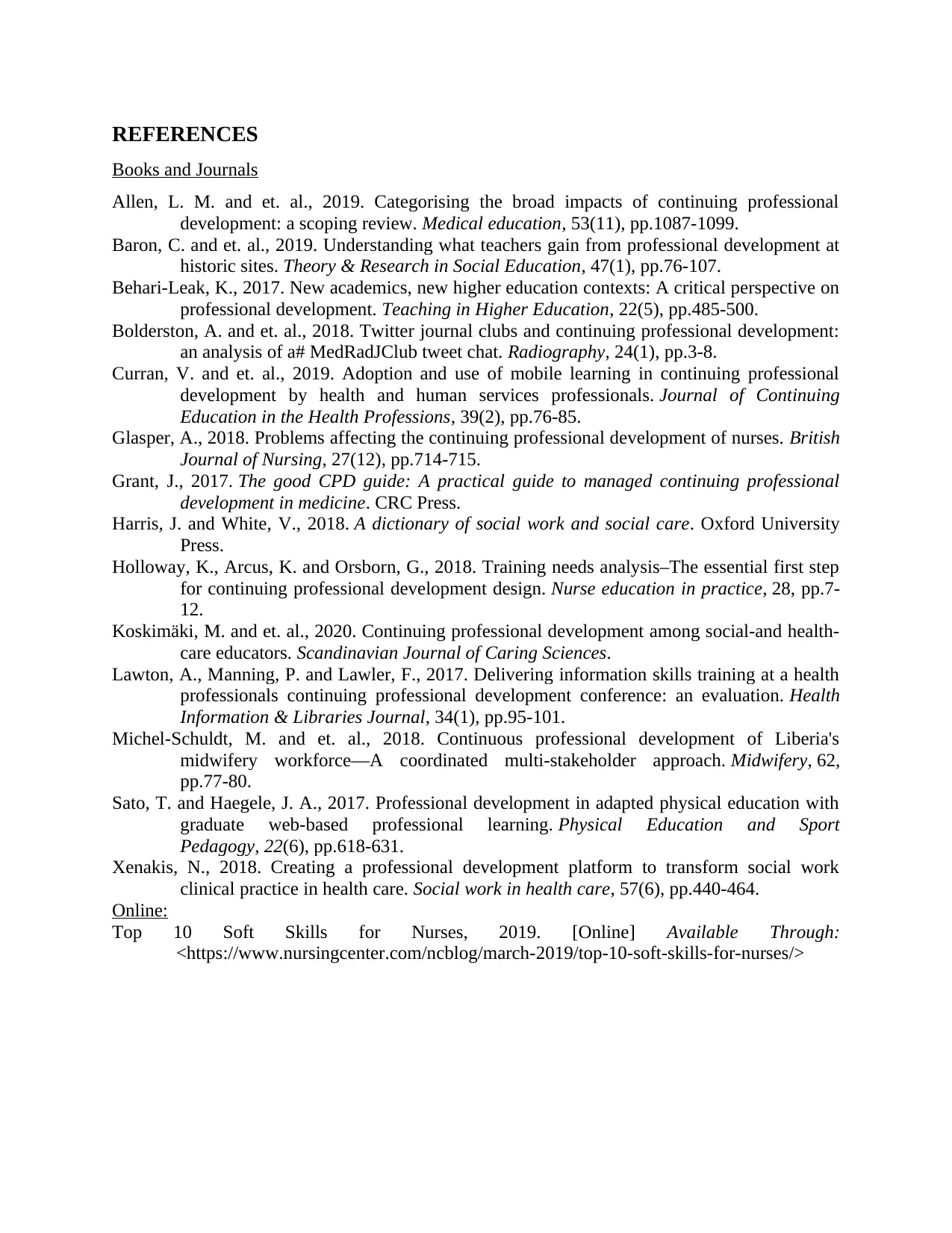
REFERENCES
Books and Journals
Allen, L. M. and et. al., 2019. Categorising the broad impacts of continuing professional
development: a scoping review. Medical education, 53(11), pp.1087-1099.
Baron, C. and et. al., 2019. Understanding what teachers gain from professional development at
historic sites. Theory & Research in Social Education, 47(1), pp.76-107.
Behari-Leak, K., 2017. New academics, new higher education contexts: A critical perspective on
professional development. Teaching in Higher Education, 22(5), pp.485-500.
Bolderston, A. and et. al., 2018. Twitter journal clubs and continuing professional development:
an analysis of a# MedRadJClub tweet chat. Radiography, 24(1), pp.3-8.
Curran, V. and et. al., 2019. Adoption and use of mobile learning in continuing professional
development by health and human services professionals. Journal of Continuing
Education in the Health Professions, 39(2), pp.76-85.
Glasper, A., 2018. Problems affecting the continuing professional development of nurses. British
Journal of Nursing, 27(12), pp.714-715.
Grant, J., 2017. The good CPD guide: A practical guide to managed continuing professional
development in medicine. CRC Press.
Harris, J. and White, V., 2018. A dictionary of social work and social care. Oxford University
Press.
Holloway, K., Arcus, K. and Orsborn, G., 2018. Training needs analysis–The essential first step
for continuing professional development design. Nurse education in practice, 28, pp.7-
12.
Koskimäki, M. and et. al., 2020. Continuing professional development among social‐and health‐
care educators. Scandinavian Journal of Caring Sciences.
Lawton, A., Manning, P. and Lawler, F., 2017. Delivering information skills training at a health
professionals continuing professional development conference: an evaluation. Health
Information & Libraries Journal, 34(1), pp.95-101.
Michel-Schuldt, M. and et. al., 2018. Continuous professional development of Liberia's
midwifery workforce—A coordinated multi-stakeholder approach. Midwifery, 62,
pp.77-80.
Sato, T. and Haegele, J. A., 2017. Professional development in adapted physical education with
graduate web-based professional learning. Physical Education and Sport
Pedagogy, 22(6), pp.618-631.
Xenakis, N., 2018. Creating a professional development platform to transform social work
clinical practice in health care. Social work in health care, 57(6), pp.440-464.
Online:
Top 10 Soft Skills for Nurses, 2019. [Online] Available Through:
<https://www.nursingcenter.com/ncblog/march-2019/top-10-soft-skills-for-nurses/>
Books and Journals
Allen, L. M. and et. al., 2019. Categorising the broad impacts of continuing professional
development: a scoping review. Medical education, 53(11), pp.1087-1099.
Baron, C. and et. al., 2019. Understanding what teachers gain from professional development at
historic sites. Theory & Research in Social Education, 47(1), pp.76-107.
Behari-Leak, K., 2017. New academics, new higher education contexts: A critical perspective on
professional development. Teaching in Higher Education, 22(5), pp.485-500.
Bolderston, A. and et. al., 2018. Twitter journal clubs and continuing professional development:
an analysis of a# MedRadJClub tweet chat. Radiography, 24(1), pp.3-8.
Curran, V. and et. al., 2019. Adoption and use of mobile learning in continuing professional
development by health and human services professionals. Journal of Continuing
Education in the Health Professions, 39(2), pp.76-85.
Glasper, A., 2018. Problems affecting the continuing professional development of nurses. British
Journal of Nursing, 27(12), pp.714-715.
Grant, J., 2017. The good CPD guide: A practical guide to managed continuing professional
development in medicine. CRC Press.
Harris, J. and White, V., 2018. A dictionary of social work and social care. Oxford University
Press.
Holloway, K., Arcus, K. and Orsborn, G., 2018. Training needs analysis–The essential first step
for continuing professional development design. Nurse education in practice, 28, pp.7-
12.
Koskimäki, M. and et. al., 2020. Continuing professional development among social‐and health‐
care educators. Scandinavian Journal of Caring Sciences.
Lawton, A., Manning, P. and Lawler, F., 2017. Delivering information skills training at a health
professionals continuing professional development conference: an evaluation. Health
Information & Libraries Journal, 34(1), pp.95-101.
Michel-Schuldt, M. and et. al., 2018. Continuous professional development of Liberia's
midwifery workforce—A coordinated multi-stakeholder approach. Midwifery, 62,
pp.77-80.
Sato, T. and Haegele, J. A., 2017. Professional development in adapted physical education with
graduate web-based professional learning. Physical Education and Sport
Pedagogy, 22(6), pp.618-631.
Xenakis, N., 2018. Creating a professional development platform to transform social work
clinical practice in health care. Social work in health care, 57(6), pp.440-464.
Online:
Top 10 Soft Skills for Nurses, 2019. [Online] Available Through:
<https://www.nursingcenter.com/ncblog/march-2019/top-10-soft-skills-for-nurses/>
1 out of 15
Your All-in-One AI-Powered Toolkit for Academic Success.
+13062052269
info@desklib.com
Available 24*7 on WhatsApp / Email
![[object Object]](/_next/static/media/star-bottom.7253800d.svg)
Unlock your academic potential
© 2024 | Zucol Services PVT LTD | All rights reserved.




